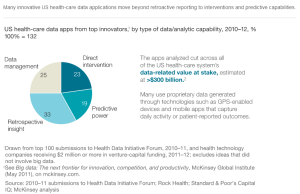Jointly Health is the first Big Data Analytics and Closed-Loop Decision Support Platform for Remote Patient Monitoring
From their website:
Company Overview
Jointly Health is a venture-backed company headquartered in Orange County, CA. In collaboration with Qualcomm Life, Jointly Health provides a very disruptive, end-to-end Remote Patient Monitoring and Analytics Platform that can detect changes in health states much earlier and with greater specificity. Jointly Health also makes this information actionable by healthcare professionals inside their existing workflow.
First Application
The first application of Jointly Health is to reduce preventable hospital admissions in patients with complex chronic disease. In the U.S. there are 4 million preventable hospitalizations resulting in $88 billion in preventable costs and unquantifiable amounts of human suffering. Remote patient monitoring has the potential to reduce these hospitalizations but is plagued by missed intervention opportunities, false alarms and inefficiencies. Jointly Health solves these problems.
Uniqueness
Jointly’s proprietary platform utilizes a number of advanced technologies including Predictive Analytics, Complex-Event Processing, Real-Time Analytics, Signal Processing and Machine Learning and has four distinct advantages.
1. Can collect a wide variety of remote health data at high velocity and volume. This includes multiple types of physiological data, human observational, environmental, contextual, and other meta data.
2. Has an adaptable ecosystem that enables our customers to build complex disease models which we can then execute.
3. Can remotely detect changes in health states much earlier and with greater specificity.
4. Provides healthcare professionals with a closed-loop decision support system for intervention optimization.
————-
From: http://www.medgadget.com/2013/11/futuremed-day-4-the-end-of-the-beginning.html
Kreindler elaborated on the value of high speed data for applications including remote patient monitoring and analytics to proactively detect deteriorating health states before they being to detract from quality of life. The energetic talk concluded by touching on how Jointly Health, in collaboration with Qualcomm Life, harnesses big data and analytics to make “information actionable.”
